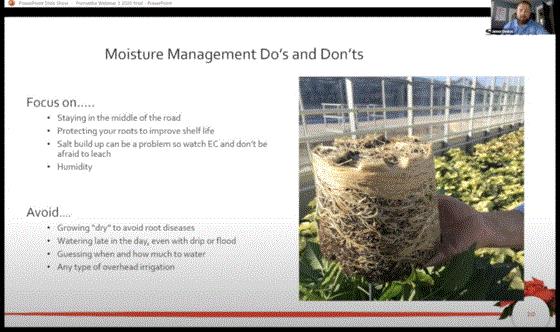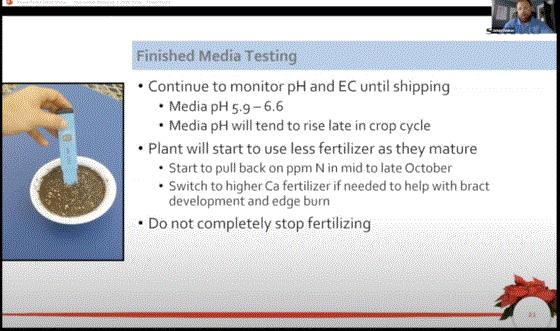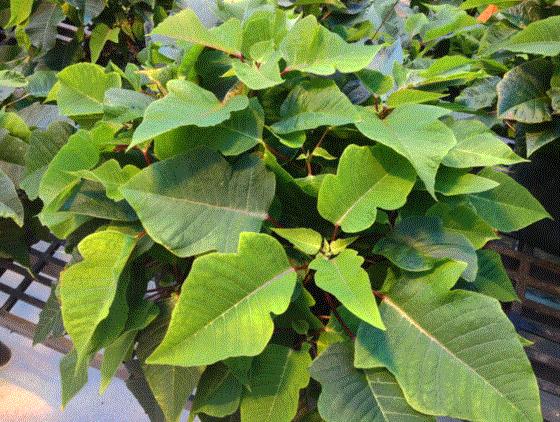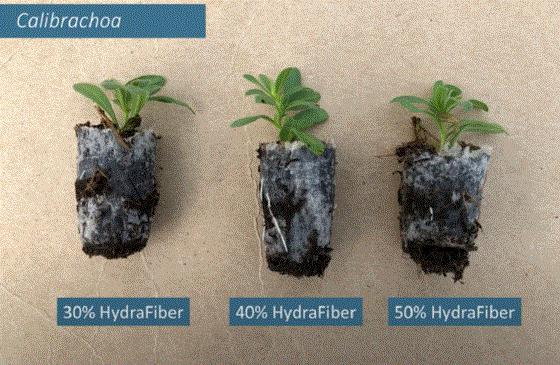Managing Moisture in Finished Poinsettias
As we continue to break down poinsettia season with short, timely videos each week, we’re now on to moisture management in the finishing stages.
With this important topic, our experts cover what to focus on and what NOT to do. Your team needs to pay close attention to keeping the crop at the right moisture level by staying "middle of the road." Be sure to watch your EC levels and don’t be afraid to leach, as well as staying on top of changing humidity levels. Avoid growing dry, watering late in the day, and guessing how much to water.

Above all else, stay away from overhead irrigation when finishing your poinsettia crop.
Check out VIDEO #27 for the complete discussion.
Poinsettia Video 28: Finished Media Testing & Nutrition Tips
Even though you’re nearing the end of the 2021 poinsettia crop, now is not the time to let your guard down!
In VIDEO 28, our presenters from Selecta One spend time discussing finished media testing and EC management. You want to continue to keep a close eye on pH and EC until the time of shipping, as pH tends to rise as you finish the crop.
Your poinsettias will also start to use less fertilizer as they mature toward the end of October. At this time, you might want to switch to a higher-calcium fertilizer to help with bract development. Remember, don’t completely stop fertilizing or you’ll start to see deficiencies.

These videos, as well as 25 more squarely focused on poinsettia production, are available in a dedicated YOUTUBE PLAYLIST to help you and your team finish the best crop ever. After you watch the poinsettia videos, check out the other Tech on Demand playlists for dozens more training videos.
Nick’s Tip of the Week: Managing Late Stretch in Poinsettias
Each week, I’ll work with my friend Nick Flax, a technical services expert at Ball, to share a concern that’s come up during one of his numerous calls with growers across North America. This week he’s covering ways to combat your poinsettia crop jumping up late in the production cycle.
PROBLEM: We’re getting ever closer to poinsettia shipping season! October is almost over and those of you producing points under natural daylengths are heaving sighs of relief now that you’ve begun to see some meaningful color show up on the bracts. At this point in the game, many of you switch production over to autopilot, but this week’s tip is a cautionary tale, understanding that you’re probably ready to be done growing this year’s poinsettia crop.
Several communications I’ve had with growers this week boiled down to, “My poinsettias looked great until about a week ago, but they jumped and are now almost too tall. What can I do to slow them down?”

NICK’S TIP: Plant growth regulators (PGRs) are going to be your most powerful tool to curb late stretch, but here’s some food for thought on what to apply, how to apply it, and other considerations to help reduce stretch potential.
Growth Regulation
-
Paclobutrazol (Bonzi, Piccolo, Paczol) is the best active ingredient to use at this point.
-
Don’t use daminozide (such as B-nine) and chlormequat chloride (such as Cycocel) after October 10, to avoid potential phytotoxicity or delaying coloring of bracts.
-
Drench, don’t spray. A low-rate drench (0.1 ppm) will provide uniform growth control across the whole plant.
-
Spraying will reduce stretch, but height suppression will be more localized to the upper foliage/bracts and provide limited control of stretch on lower nodes.
-
Correct drench volume is critical. Apply 1 fl. oz. per inch of container size and add an additional 1 fl. oz. per additional plant in the same container (For example: drench volume for a 6-in. crop at 1ppp = 6 fl. oz.; volume for an 8-inch crop at 3ppp = 10 fl. oz.).
-
Note: Applying a 0.25 ppm paclobutrazol drench will bring crops to a dead stop.
-
Use graphical tracking to determine how close to your finished spec you are before applying PGRs. “Going with your gut” may result in too-short plants at finish.
Crop Culture &Environment Management
-
Allowing the canopy to fill in after pinch and before initial spacing helps encourage a tight, upright V-shaped habit, but spacing your crop at the right time is critical. If plants are grown too tight approaching finish, internode stretch pressure throughout the canopy will be a persistent challenge. Though allocating additional labor to poinsettias is not ideal, giving your crop some additional room on the bench can be a good alternative height control strategy if you’re nervous about late-applying PGRs like paclobutrazol.
-
As with most crops, overwatering and high relative humidity will encourage stretch in poinsettias. Don’t get lazy at the end of the hose and “water for the weekend” too often, especially with dropping temps and lower light levels. Reducing the amount of moisture applied when crop demand for water is low is a solid 2-for-1 to reduce stretch (not to mention reduce disease and pest pressure).

Water-By-Weight Resources
I’ve gotten a handful of requests over the past couple weeks for resources related to Water by Weight (WbW) and assistance training production teams on how to approach irrigation from a more scientific perspective. Thankfully, Tech on Demand has multimedia digital content to fit any learning style, from print to video to podcasts.

The basic premise is that when you water by weight—or at least present your team with an objective visual (and semantic) target—your results will improve. You may know intuitively when a plant or tray needs water based on your years of experience, but not everyone in your organization does, and across a team, many factors can vary.
Knowing wet and dry targets is critical to creating the best environment to achieve the growth you want from a crop. Too wet causes all sorts of problems, from poor growth to disease, while too dry for too long is tough to recover from.
Get your team on the same page, speaking the same watering language as you head into 2022. Here are all the resources you need to train your team to water properly:
VIDEO
SLIDESHOW
PODCAST: The Language of Watering
PODCAST: Watering – The Rest of the Story
GrowerTalks ARTICLE

Using HydraFiber in Ellepot Propagation
A while back, GrowerTalks’ editor Chris Beytes hosted a webinar with experts from The Blackmore Company and Profile Products to discuss HOW WOOD FIBER SUBSTRATES WORK IN THE ELLEPOT PROPAGATION SYSTEM. Profile’s HydraFiber has been used successfully in vegetative liner production, as well as bedding plants, poinsettias, direct-stick applications, garden mums, shrubs and perennials.

In the webinar, Dr. Bill Argo from Blackmore and Daniel Norden from Profile shared trial information, tips and tons of advice on how to achieve success incorporating this new substrate into you propagation strategy. They advise on what crops perform best, how to manage nutrition and water, specific fiber sizes to select and substrate formulations to consider.
As you evaluate your media components in the coming years, this information can be invaluable for you and your team’s decision-making.
Tech Tip: Phytotoxicity on Viola
As we head into the spring 2022 production season in North America, I’ll continue to share plenty of quick cultural and technical tips each week, based on reports from Tech On Demand team members around the world. Seeing real-world production challenges and reading solutions and advice can only help fill your toolbox and arm you with information if and when you see similar issues in your own production. We collect hundreds of photos each month and are building quite a database of tech tips. It’s easy for me to jump in and snag a photo and how we responded.

Here’s a perfect example: A grower saw this (above) in his production and was concerned about spray damage. Here’s the reply and some words of advice:
In the photo, the new flowers are free of spots. This indicates the old flowers had been damaged during a chemical (fungicide) application earlier in production, when the new flowers were still in bud stage. Be careful spraying fungicides on open flowers. Always test or avoid spraying on open flowers.

Finish Line …
I get the sense from talking to folks in my life that everyone is exhausted. Life has not been easy these last couple years, and overall stress and strain seems to be at a high level. This goes for people of all ages and walks of life. I don’t think horticulture is immune to this.

I’m not trying to turn Tech On Demand into a self-help newsletter, but this is something I read recently that I have to share. Somehow, I followed a link I saw somewhere and ended up reading five tips on managing stress. They were pretty straightforward but made a lot of sense. I’m adding my own interpretations here since I honestly can’t find the exact article again.
-
Review and organize. Sometimes just taking a few minutes to organize tasks can help with prioritization and reduce anxiety.
-
Take a break. Mindfulness, meditation and all sorts of practices have helped people manage stress for generations. Just stepping away from your desk or work for a short time each day can do wonders.
-
Keep moving. Exercise is powerful. You don’t need to run a marathon every day. Just a short walk outside can help you reset.
-
Rest. Get some sleep. Make it a priority. Put your phone down, turn off the TV and get some extra hours in.
-
Lean into it. Don’t run from stress. Address it head on. You’ll learn more about it and be able to make smarter decisions.



As always, my email is bcalkins@ballhort.com if you have any comments, suggestions or challenges we can help solve.

Bill Calkins
Editor - Tech On Demand
This email was received by you and 25,354 other fine subscribers!
If you're interested in advertising in Tech On Demand, contact Kim Brown ASAP and she'll hook you up.